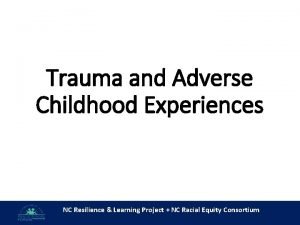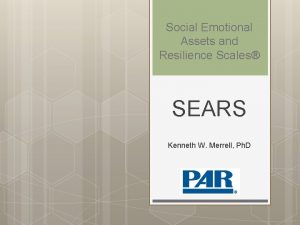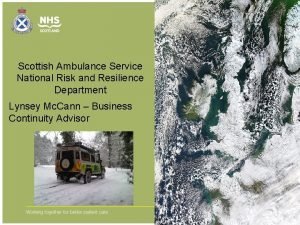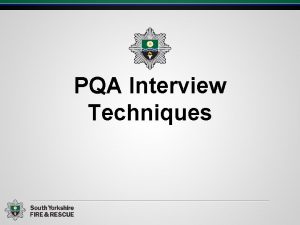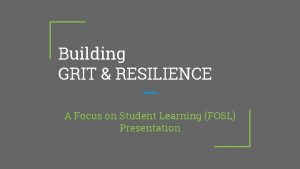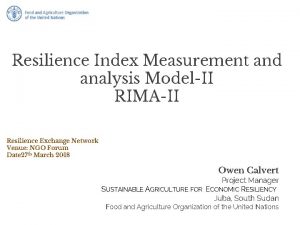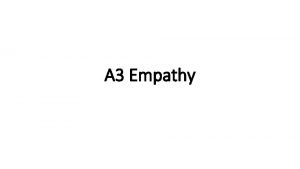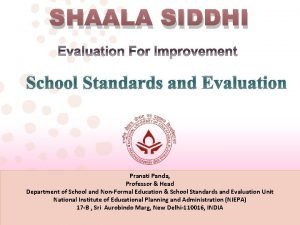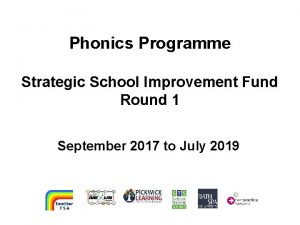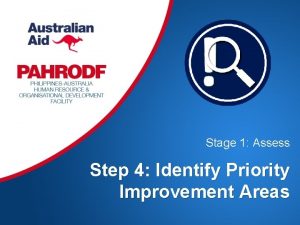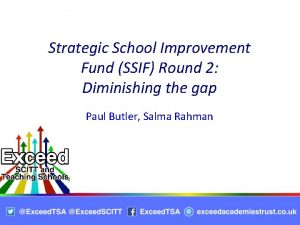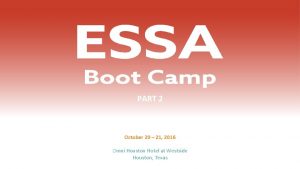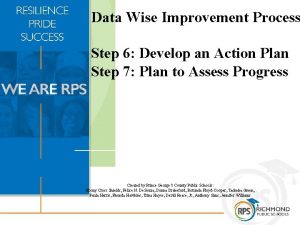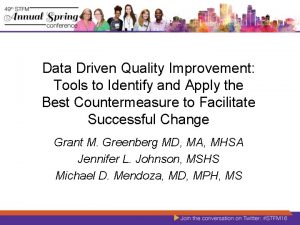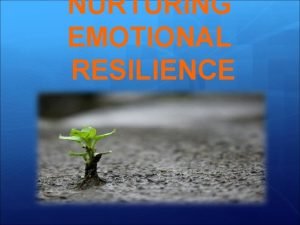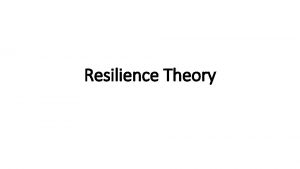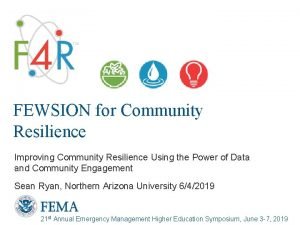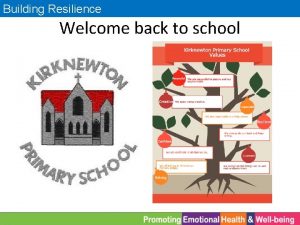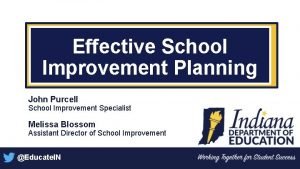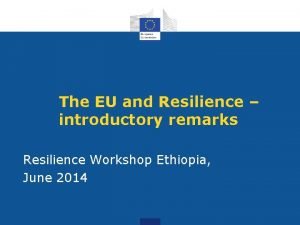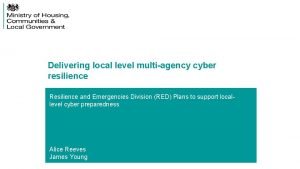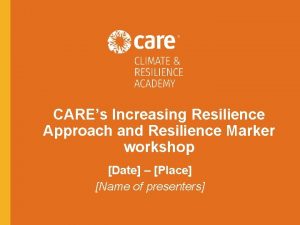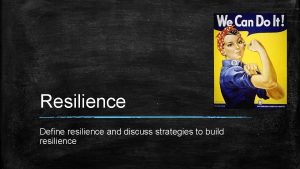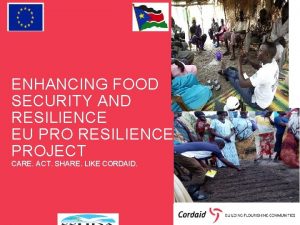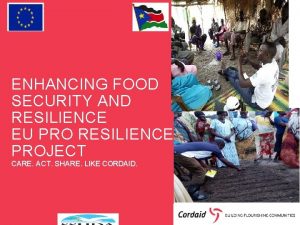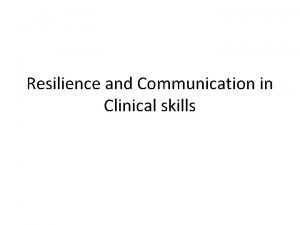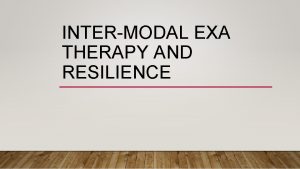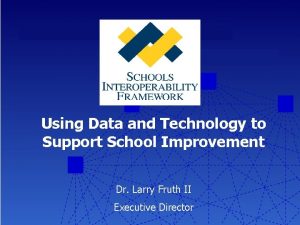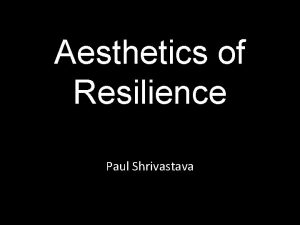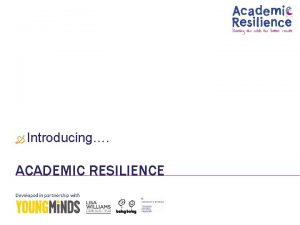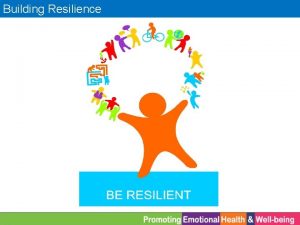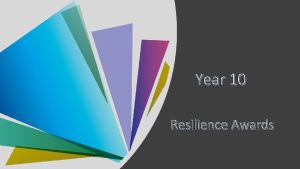Using Your Data For School Improvement Resilience and










































- Slides: 42

Using Your Data For School Improvement Resilience and Youth Development To participate: call into 1. 866. 330. 1200 then enter 2186577 #

Workshop Overview Part 1 Intro to Protective Factors (PF) Resilience Scales Resilience & Youth Development Model Part 2 Research: PF and School Improvement Research: Benefits of PF (West. Ed) Closing The Achievement Gap (CTAG) Part 3 How we increase ‘Protective Factors’ Strategies to increase ‘Protective Factors’ Links to workshops & resources

Intro to Protective Factors Research shows that supportive schools and communities foster positive outcomes by promoting students’ sense of: Connectedness (1997) Resnick et al. , Belonging (1995) Baumeister & Leary, Community (1997) Schaps, et al. , Protective Factors (1991) Benard

Intro to Protective Factors California Healthy Kids Survey (CHKS) collects student data on Protective Factors 3 Protective factors Caring Relationships, High Expectations, Meaningful Participation School Protective Factor Score Community Protective Factor Score Also collects data on School Connectedness (Add Health) Degree to which students feel close to people at school, a part of the school, treated fairly, happy, and safe at school. Found to be protective against every health risk measure

Resilience Scales The RYD chart in every CHKS Main Report highlights Protective Factor Scores as well as School Connectedness

Resilience Scales Often the easiest way to decipher these percentages is to concentrate on those scoring ‘High’ and comparing to previous reports and state averages

Resilience Scales Using CSCS (staff responses)

Resilience Scales Since 0708 the Main Reports also have the RYD charts disaggregated by ethnicity (6 major ethnicities) American Indian or Alaska Native Hawaiian or Pacific Islander Asian Black or African American Hispanic or Latino/Latina White or Caucasian

Protective Factors Caring Relationships School High Expectations Community Meaningful Participation 9

Resilience & Youth Development Model Resilience In Action

Resilience & Youth Development Model Key Data Points Along The Model CSCS staff Belief CHKS student CSCS staff Protective Factors CHKS student School Connectedness CHKS student Personal Resilience Strengths CHKS student Risk-taking STAR tests…

Resilience & Youth Development Model

Resilience & Youth Development Model School Improvement Environmental Inputs Protective Factor Scores

14 Resilience & Youth Development Model www. wested. org/cs/chks/view/rs/712

Questions? Re: Protective Factors, RYDM Scales

Research… Protective Factors and School Improvement The 3 R’s of the Bill and Melinda Gates Foundation Relevance … Meaningful Participation Rigor… High Expectations Relationships… Caring Relationships 16

Research… Protective Factors and School Improvement High Performing Learning Communities Strong connections between students and staff. A set of high expectations and a rigorous curriculum… Instructional strategies that engage students… A school culture that is mission-driven and Focused on helping all students learn. Catherine Walcott, et al High School Reform: National & State Trends, West. Ed 2005 17

Research… Protective Factors and School Improvement Consortium on Chicago School Research Schools with high trust levels are 3 x more likely to report gains in reading & math scores. Schools in top quartile on standardized tests had higher levels of trust. Bryk, A. & Schneider, B. , Chicago Consortium, 2002 18

Research… Protective Factors and School Improvement Engaging Schools: Fostering High School Students’ Motivation to Learn Personalization of school experience High & clear standards Meaningful and engaging pedagogy & curriculum Professional learning communities for adults National Research Council Institute of Medicine National Academy of Science, 2004 19

Research… Protective Factors and School Improvement Institutional Success Any institution that wants to claim success for the majority of its youth participants needs to be intentional about creating tight, challenging, learning communities that are focused on the whole adolescent and that are built to bring young people from wherever they are to the finish line. Karen Pittman, Forum for Youth Investment 20

Research… Protective Factors and School Improvement Getting Results Research shows that young people who engage in meaningful participation in school and community activities have improved chances for positive and healthy development… Getting Results, 1999, 2001 Pittman, Martin & Williams, 2007 21

Research: Benefits of Protective Factors (West. Ed) Academics Health Safety and ATOD Use protective factors

Research: Benefits of Protective Factors (West. Ed) www. wested. org/pub/docs/chks_health. html 23

Research: Benefits of Protective Factors (West. Ed) Caring Relationships and Test Scores High Expectations and Test Scores Meaningful Participation and Test Scores Resilience research identify these factors as beneficial influences Sad/Hopelessness and Test Scores And are associated with both a lack of involvement in health comprising behaviors and academic success

Research: CR and Academics (West. Ed) Change in SAT-9 (NPR) 10 5 0 0. 1 0. 8 0. 4 1. 2 0. 8 1. 1 1. 5 1. 9 2. 2 0. 5 1. 0 1. 5 2. 1 2. 7 -0. 3 Reading -5 Language Mathematics -10 52 58 64 71 77 52 Percent reporting caring relations with adults at school Source: California Healthy Kids Survey & STAR data files. 58 64 71 77

Research: HE and Academics (West. Ed) Change in SAT-9 (NPR) 10 5 0. 9 0. 4 0 -0. 5 1. 4 1. 0 1. 2 1. 4 1. 7 1. 9 0. 8 1. 1 1. 5 1. 9 2. 3 -0. 1 Reading -5 Language Mathematics -10 58 65 72 80 87 58 Percent reporting high expectations at school Source: California Healthy Kids Survey & STAR data files. 65 72 80 87

Research: MP and Academics (West. Ed) Change in SAT-9 (NPR) 10 5 0. 0 0 1. 1 0. 5 1. 5 0. 6 1. 1 1. 5 2. 0 2. 5 1. 0 1. 3 1. 6 2. 0 2. 2 -0. 5 Reading -5 Language Mathematics -10 48 55 62 70 77 48 Percent in school reporting meaningful participation in community Source: California Healthy Kids Survey & STAR data files. 55 62 70 77

Research: Mental Health and Academics (West. Ed) Change in SAT-9 (NPR) 10 5 1. 5 2. 4 1. 0 0. 7 2. 0 2. 6 1. 6 0. 3 0 1. 2 2. 1 0. 7 1. 1 0. 6 -0. 2 Reading -5 Language Mathematics -10 20 25 29 34 39 20 Percent reporting sadness/hopelessness (12 month) Source: California Healthy Kids Survey & STAR data files. 25 29 34 39

Research: Benefits of Protective Factors (West. Ed) Safety High SPF scores are also associated with improvements in safe school environment, a necessary precondition of learning ATOD Use Lack of School Protective Factors are associated with substance use and disengagement from school Health High SPF scores promote feelings of connectedness, security, and wellbeing

School & Community Serving Non-serving Relationship: Protective Factors and …Service Learning 2004 -2006 weighted CHKS data n=700, 000 students

Relationship: Protective Factors and …Ethnicity Hispanic African-American White mean % of students for School Connectedness by ethnicity 2004 -2006 weighted CHKS data n=700, 000 students

Relationship: Protective Factors and …CTAG Jack O’Connell’s Closing the Achievement Gap Initiative Student perceptions concerning… extra help with schoolwork, academic rigor, the cultural relevance of lessons, equity in opportunities, and fair and respectful treatment of all students. Free Plus free-of-charge special CTAG report www. wested. org/chks/ctag

Questions? Re: Research, Relationships, CTAG

How we increase ‘school protective factors’ Educators… Know this, it is neither new nor a revelation. Should view this as a ‘pat on the back’. Keep doing what you know works. Spread the word - the numbers and the research supports what many inherently know.

How we increase ‘school protective factors’ What it looks like… Caring Relationships Meaningful Participation High Expectations Available and accessible Model caring Shows interest Compassion Listening & dialogue Patience Basic trust Safety Inclusion Responsibility Voice & choice Youth-driven Experiential pedagogy Contribution Peer support Empowerment Demonstrates belief Challenge & support Firm guidance Structure & rituals Strengths-focused

How we increase ‘school protective factors’ What it sounds like… Caring Relationships Meaningful Participation High Expectations Be there. Get to know our stories. They help me by listening and encouraging me. They talk to me as a person and friend, not just as a student. Ask, How was your weekend? But also… Listen & give eye contact. Know our names. Active learning, more discussions. Show me how to do it. Get the fun into class! Do group projects. We can share ideas. I want to help tutor little kids in reading and math. Kids helping kids School is a community. It’s not a building but about people. They say, I believe in you …simple as that. They say, You can succeed in life. They brag about you. Encouragement is key. They say You can do better. They see you after class and say See you in the future.

How we increase ‘school protective factors’ Caring Relationships Classroom Both School One-to-one time with students. Personal contact. Listen. Outside classroom. Be available (‘be there’). Student focus groups. Take the students’ recommendations to heart and act on them. School climate task force. Teacher mentoring. Encourage more community involvement. Staff focus groups. Staff support groups. Team-teaching. Class-size reduction. Suggestions from: Resilience and Youth Development Module Handbook (2004), West. Ed.

How we increase ‘school protective factors’ Meaningful Participation Classroom Both School Involve students in lesson planning and class rules. Provide student time to discuss/respond. Ask student opinions. Choice of assignments. Encourage self-reflection, critical thinking. Hands-on. Project-based. Co-operative learning. Involve students in lesson/curriculum planning. Establish peer helping/tutoring programs. Involve students in all aspects of school policy (curriculum, school beautification, discipline etc. ). Community Service Learning. Alternatives to suspension policies. Suggestions from: Resilience and Youth Development Module Handbook (2004), West. Ed.

How we increase ‘school protective factors’ High Expectations Classroom Both School Encourage. Adapt lessons to level of learner. Individualize learning. Set clear goals. Set clear guidelines. Link assessment directly to goals. Importance of youth developing a belief in their own academic competence… Or, stated more simply, the need for you to believe that they are smart, can learn, and become smarter through study. College campus visits for all students. Thematic, experiential, challenging, and comprehensive curriculum. Broad range of learning styles. Highlight/celebrate achievement. Staff training on Academics and Connectedness. Revisit progress during staff meetings.

Other Tools Closing The Achievement Gap: Toolkit Fall 2009 (CDE, P 16, West. Ed) Enhancing School Climate To Help Close The Achievement Gap School Climate, Ethnicity, Migrant Education, Special Education Additional workshops … From Risk to Resilience Listening to Youth "You Matter!" Promoting R&YD Your After-School Program www. wested. org/resilience Related Resources… Resiliency: What We Have Learned Fostering Resiliency in Kids Ensuring That No Child Is Left Behind www. wested. org/chks and click on ‘research’

41 50 years of resilience research tells us that… when the focus is on supporting and empowering youth, over 70% of young people in the most challenging of life’s conditions not only survive, but grow into thriving adults. Bonnie Benard

42 www. wested. org/chks www. wested. org/cscs Sean Slade sslade@wested. org
 Nc resilience and learning project
Nc resilience and learning project Social emotional assets and resilience scales pdf
Social emotional assets and resilience scales pdf National risk and resilience department
National risk and resilience department What does pqa stand for
What does pqa stand for Building grit and resilience
Building grit and resilience Resilience index measurement and analysis
Resilience index measurement and analysis Attachment and emotional resilience theory
Attachment and emotional resilience theory Shaala siddhi school evaluation composite matrix
Shaala siddhi school evaluation composite matrix Sip/aip based monitoring and evaluation instrument tool
Sip/aip based monitoring and evaluation instrument tool Strategic school improvement fund round 3
Strategic school improvement fund round 3 Data collection plan examples
Data collection plan examples School improvement plan michigan
School improvement plan michigan Strategic school improvement fund round 3
Strategic school improvement fund round 3 School improvement plan
School improvement plan Swot analysis for school
Swot analysis for school Strategic school improvement fund round 3
Strategic school improvement fund round 3 Give us your hungry your tired your poor
Give us your hungry your tired your poor Data wise ace habits of mind
Data wise ace habits of mind Data driven quality
Data driven quality Example of article for school magazine
Example of article for school magazine Fspos vägledning för kontinuitetshantering
Fspos vägledning för kontinuitetshantering Typiska drag för en novell
Typiska drag för en novell Tack för att ni lyssnade bild
Tack för att ni lyssnade bild Ekologiskt fotavtryck
Ekologiskt fotavtryck Shingelfrisyren
Shingelfrisyren En lathund för arbete med kontinuitetshantering
En lathund för arbete med kontinuitetshantering Kassaregister ideell förening
Kassaregister ideell förening Tidbok
Tidbok Sura för anatom
Sura för anatom Vad är densitet
Vad är densitet Datorkunskap för nybörjare
Datorkunskap för nybörjare Stig kerman
Stig kerman Mall debattartikel
Mall debattartikel För och nackdelar med firo
För och nackdelar med firo Nyckelkompetenser för livslångt lärande
Nyckelkompetenser för livslångt lärande Påbyggnader för flakfordon
Påbyggnader för flakfordon Formel för lufttryck
Formel för lufttryck Publik sektor
Publik sektor Lyckans minut erik lindorm analys
Lyckans minut erik lindorm analys Presentera för publik crossboss
Presentera för publik crossboss Teckenspråk minoritetsspråk argument
Teckenspråk minoritetsspråk argument Kanaans land
Kanaans land Klassificeringsstruktur för kommunala verksamheter
Klassificeringsstruktur för kommunala verksamheter
